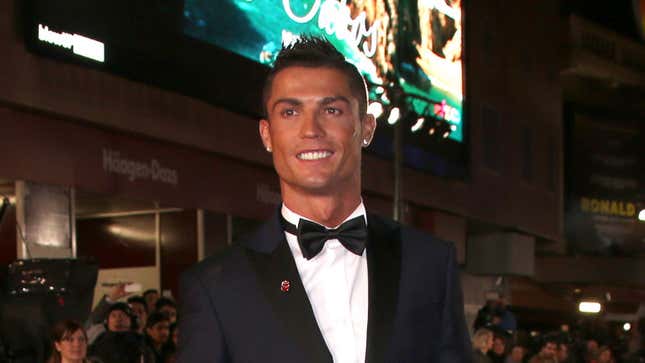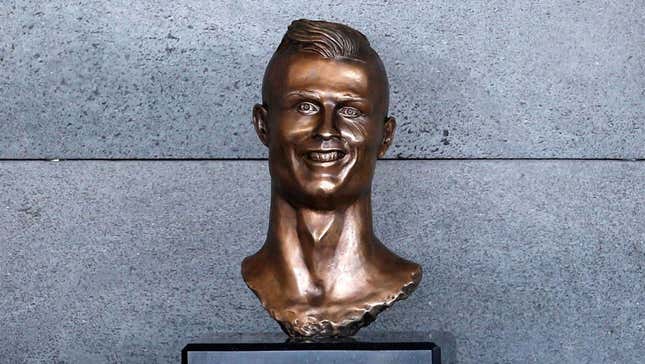Emanuel Santos had a dream, and it’s painful, actually, to contemplate just how much of it came true.
Think of it: Santos, a 41-year-old, self-taught sculptor, talks his way into the commission of a lifetime, creating a bust of his hometown’s favorite son. His statue will greet people arriving at an airport soon to be renamed for this famous former resident, the same airport where the sculptor works a day job collecting abandoned luggage trolleys.
After shifts at the airport, and after putting his young son to bed, the sculptor labors in his workshop, working from photographs of his subject’s well-known face. The statue is a tribute: to this town, to the local hero, to the sculptor’s supportive wife (who checks in on him in the studio and shoos their child away from the breakable stuff), to his own belief in his ability to create a new life for himself as an artist.
And then the sculpture is unveiled. The subject grins and signs a ball for the sculptor’s son. The cameras flash. He did it. He’s an artist now.
The dream, however, quickly turns into the stuff of nightmares. Friends and family start calling the sculptor to ask if he’s seen the things strangers are writing on the internet about his work. The criticism comes from all corners of the globe, in languages Santos can’t even read. Some of it is unspeakably crass. Some of it is unspeakably cruel. A year later, asked to recall the days following the proudest moment of his life, Santos hides his face in his hand.
Santos is a lifelong resident of Madeira, a Portuguese island 300 miles off the coast of Morocco. Madeira is also the birthplace of Cristiano Ronaldo, a forward for the Real Madrid football team and the only man on earth with more Instagram followers than the Rock.
Ronaldo himself unveiled the bust at the newly rechristened Cristiano Ronaldo International Airport on March 29, 2017. Within hours, Santos was the most famous artist in the world for the worst possible reason.
This was the famously chiseled face that Santos was tasked with sculpting.

And this is the bust Santos made of him.

Does Santos’s sculpture look like Ronaldo? No. The features are a little more lopsided, the eyes closer together, the grin a little goofier. It is not a bad sculpture of a male human face, especially from an artist who completed his first work only in 2016. It just doesn’t resemble the face that presently belongs to Ronaldo.
The reviews were brutal. Headlines called his statue “bizarre” and “horrifying.” Photoshopped memes superimposed the statue’s uneven grin on real photographs of Ronaldo and on the sewer scene from It. Some of the criticism was funny-mean, and some of it was weirdly, viciously mean, in the way that only the internet can be. When a Guardian art critic wrote a year later that he didn’t think the original bust was that bad, a commenter replied, “you reek of piss you virgin.”
If you stop at this point, Santos’s story looks like a lesson in the dark side of pursuing a dream. Indeed, daring to step onto a bigger stage invites the possibility of public, humiliating failure. But the extraordinary choices Santos made in the aftermath of this head-spinning experience is a powerful example to everyone with the courage to try as hard as he did.
In a poignant video interview with the Bleacher Report for the one-year anniversary of the unveiling, Santos never disavows his work. Art is an subjective experience, he explains, and he had the right as an artist to interpret Ronaldo as he saw fit. Making the sculpture was a joyful experience, he says, and at the unveiling, “I was really happy and laughed with satisfaction,” Santos recalls. “I felt that feeling of fulfillment that I had done my part.”
He did not allow the response to his first big public commission to crush him. Instead, he learned from it. The Bleacher Report gave Santos a second commission: a do-over of the Ronaldo bust. The next version also is not a perfect replica of the soccer player’s face, but has a dignified look that captures more of the Madeiran’s famous cockiness.
We can draw similar inspiration from another artist whose work drew unexpected attention. Bryan Gaw, a dancer with a supporting role at the 2015 NFL Super Bowl, wrote earlier this year about the aftermath of the brief, onstage improvisation that earned him the nickname “Left Shark.”
“I was a big shark. I had to be a big shark. That’s what makes a dancer a performing artist—the ability to fill in those gaps and to interpret the work. And when you get a chance to improvise, as a dancer, that’s your moment. It’s a gift,” Gaw wrote in the Washington Post. “I’m glad it makes people happy . . . I hope other people keep following their dreams, keep growing and are never afraid to be that quintessential left shark.”
Santos’s resilience (and Gaw’s, too) shows that it’s possible to be at the receiving end of criticism, even a barrage of it, and process the useful parts without abandoning your own dignity or creative vision. How much better to be like Santos—or indeed, like the original Left Shark—and have the courage to go after your dream, than to be among the anonymous cowards shooting down the people who do.
“No one was brave enough to do what he did, to have the initiative he had, to have his idea and present it,” Santos’s wife Armanda Gouveia tells the camera in the Bleacher Report video. “Social media is for those who aren’t brave enough to say face-to-face what they think.”
As for Santos, he was commissioned to sculpt another famous footballer, Ronaldo’s Real Madrid teammate Gareth Bale. The bronze bust was unveiled last year in Bale’s hometown of Cardiff, Wales. It’s not bad at all.
